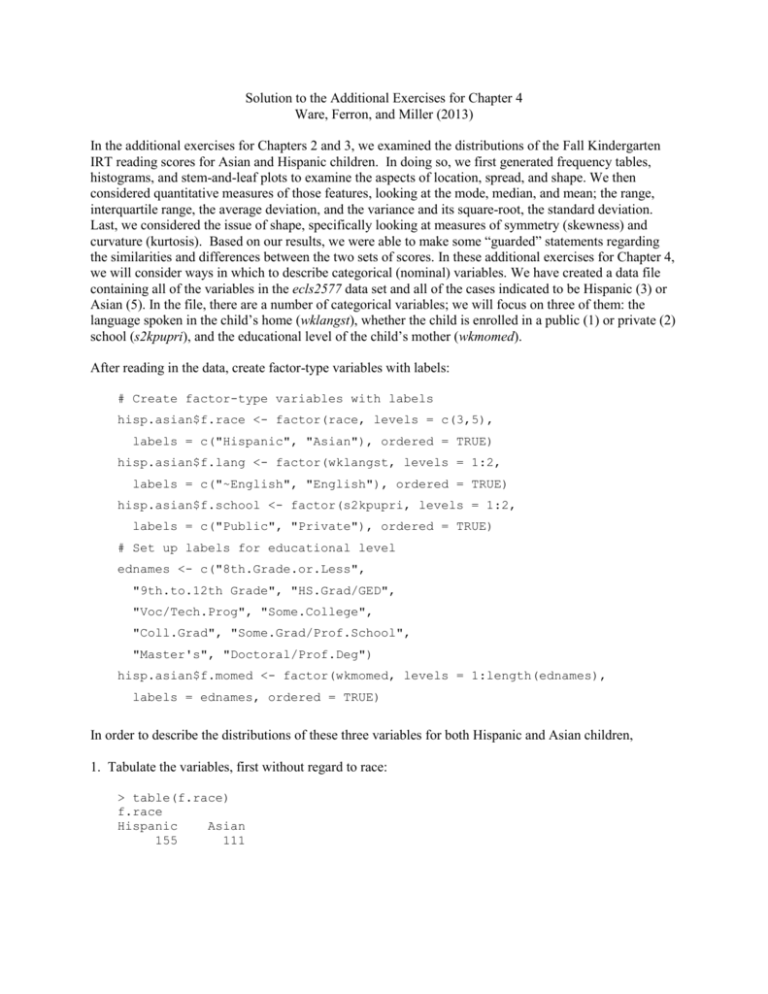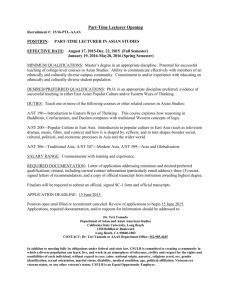Solution to the Additional Exercises for Chapter 4 Ware, Ferron, and
advertisement

Solution to the Additional Exercises for Chapter 4 Ware, Ferron, and Miller (2013) In the additional exercises for Chapters 2 and 3, we examined the distributions of the Fall Kindergarten IRT reading scores for Asian and Hispanic children. In doing so, we first generated frequency tables, histograms, and stem-and-leaf plots to examine the aspects of location, spread, and shape. We then considered quantitative measures of those features, looking at the mode, median, and mean; the range, interquartile range, the average deviation, and the variance and its square-root, the standard deviation. Last, we considered the issue of shape, specifically looking at measures of symmetry (skewness) and curvature (kurtosis). Based on our results, we were able to make some “guarded” statements regarding the similarities and differences between the two sets of scores. In these additional exercises for Chapter 4, we will consider ways in which to describe categorical (nominal) variables. We have created a data file containing all of the variables in the ecls2577 data set and all of the cases indicated to be Hispanic (3) or Asian (5). In the file, there are a number of categorical variables; we will focus on three of them: the language spoken in the child’s home (wklangst), whether the child is enrolled in a public (1) or private (2) school (s2kpupri), and the educational level of the child’s mother (wkmomed). After reading in the data, create factor-type variables with labels: # Create factor-type variables with labels hisp.asian$f.race <- factor(race, levels = c(3,5), labels = c("Hispanic", "Asian"), ordered = TRUE) hisp.asian$f.lang <- factor(wklangst, levels = 1:2, labels = c("~English", "English"), ordered = TRUE) hisp.asian$f.school <- factor(s2kpupri, levels = 1:2, labels = c("Public", "Private"), ordered = TRUE) # Set up labels for educational level ednames <- c("8th.Grade.or.Less", "9th.to.12th Grade", "HS.Grad/GED", "Voc/Tech.Prog", "Some.College", "Coll.Grad", "Some.Grad/Prof.School", "Master's", "Doctoral/Prof.Deg") hisp.asian$f.momed <- factor(wkmomed, levels = 1:length(ednames), labels = ednames, ordered = TRUE) In order to describe the distributions of these three variables for both Hispanic and Asian children, 1. Tabulate the variables, first without regard to race: > table(f.race) f.race Hispanic Asian 155 111 > table(f.lang) f.lang ~English English 65 201 > table(f.school) f.school Public Private 186 80 > table(f.momed) f.momed 8th.Grade.or.Less 2 9th.to.12th Grade 17 HS.Grad/GED 70 Voc/Tech.Prog 8 Some.College 78 Coll.Grad 58 Some.Grad/Prof.School 4 Master's 22 Doctoral/Prof.Deg 7 Then by racial group: > # Get frequency tables, saving tables for IOD > t.lang <- table(f.lang, f.race) > t.lang f.race f.lang Hispanic Asian ~English 21 44 English 134 67 > t.school <- table(f.school, f.race) > t.school f.race f.school Hispanic Asian Public 101 85 Private 54 26 > t.momed <- table(f.momed, f.race) > t.momed f.race f.momed Hispanic Asian 8th.Grade.or.Less 1 1 9th.to.12th Grade 12 5 HS.Grad/GED 44 26 Voc/Tech.Prog 5 3 Some.College 58 20 Coll.Grad 24 34 Some.Grad/Prof.School 3 1 Master's 6 16 Doctoral/Prof.Deg 2 5 2. Create barcharts: # Getting barplots par(mfrow = c(1, 2)) # Home Language - Plot for Hispanic Children with(subset(hisp.asian, subset = f.race == "Hispanic"), barplot(table(f.lang)/length(f.lang), xlab = "Home Lang. for Hispanic Children", ylab = "Proportions", ylim = c(0,1))) # Home Language - Plot for Asian Children with(subset(hisp.asian, subset = f.race == "Asian"), barplot(table(f.lang)/length(f.lang), xlab = "Home Lang. for Asian Children", ylab = "Proportions", ylim = c(0,1))) # School Type - Plot for Hispanic Children with(subset(hisp.asian, subset = f.race == "Hispanic"), barplot(table(f.school)/length(f.school), xlab = "Sch. Type for Hispanic Children", ylab = "Proportions", ylim = c(0,1))) # School Type - Plot for Asian Children with(subset(hisp.asian, subset = f.race == "Asian"), barplot(table(f.school)/length(f.school), xlab = "Sch. Type for Asian Children", ylab = "Proportions", ylim = c(0,1))) par(mfrow = c(1, 1)) # Single for Mother's Educational Level, too many bars # Mother's Educational Level - Hispanic Students with(subset(hisp.asian, subset = f.race == "Hispanic"), barplot(table(f.momed)/length(f.momed), xlab = "Mothers's Educational Level for Hispanic Children", ylab = "Proportions", ylim = c(0,1))) # Mother's Educational Level - Asian Students with(subset(hisp.asian, subset = f.race == "Asian"), barplot(table(f.momed)/length(f.momed), xlab = "Mothers's Educational Level for Asian Children", ylab = "Proportions", ylim = c(0,1))) 1.0 0.0 0.2 0.4 Proportions English ~English English 0.8 0.6 0.4 0.2 0.0 0.0 0.2 0.4 Proportions 0.6 0.8 1.0 Home Lang. for Asian Children 1.0 Home Lang. for Hispanic Children Proportions 0.6 0.8 1.0 0.8 0.6 0.4 0.0 0.2 Proportions ~English Public Private Sch. Type for Hispanic Children Public Private Sch. Type for Asian Children 1.0 0.8 0.6 0.4 0.0 0.2 Proportions 8th.Grade.or.Less Voc/Tech.Prog Master's 0.6 0.4 0.2 0.0 Proportions 0.8 1.0 Mothers's Educational Level for Hispanic Children 8th.Grade.or.Less Voc/Tech.Prog Master's Mothers's Educational Level for Asian Children 3. Calculate the indices of dispersion: > # For Language > h.vals.lang <- c(t.lang[1,1], t.lang[2,1]) > a.vals.lang <- c(t.lang[1,2], t.lang[2,2]) > # IOD for Language - Hispanic Children > indexdisp(h.vals.lang) [1] 0.468512 > # IOD for Language - Asian Children > indexdisp(a.vals.lang) [1] 0.9570652 > # For School Type > h.vals.sch <- c(t.school[1,1], t.school[2,1]) > a.vals.sch <- c(t.school[1,2], t.school[2,2]) > # IOD for School Type - Hispanic Children > indexdisp(h.vals.sch) [1] 0.9080541 > # IOD for School Type - Asian Children > indexdisp(a.vals.sch) [1] 0.7174742 > # For Mother's Educational Level > h.vals.ed <- c(t.momed[1,1], t.momed[2,1], t.momed[3,1], t.momed[4,1], + t.momed[5,1], t.momed[6,1], t.momed[7,1], t.momed[8,1], t.momed[9,1]) > a.vals.ed <- c(t.momed[1,2], t.momed[2,2], t.momed[3,2], t.momed[4,2], + t.momed[5,2], t.momed[6,2], t.momed[7,2], t.momed[8,2], t.momed[9,2]) > # IOD for Mother's Educational Level - Hispanic Children > indexdisp(h.vals.ed) [1] 0.8395942 > # IOD for Mother's Educational Level - Asian Children > indexdisp(a.vals.ed) [1] 0.8922571 Summarize…





